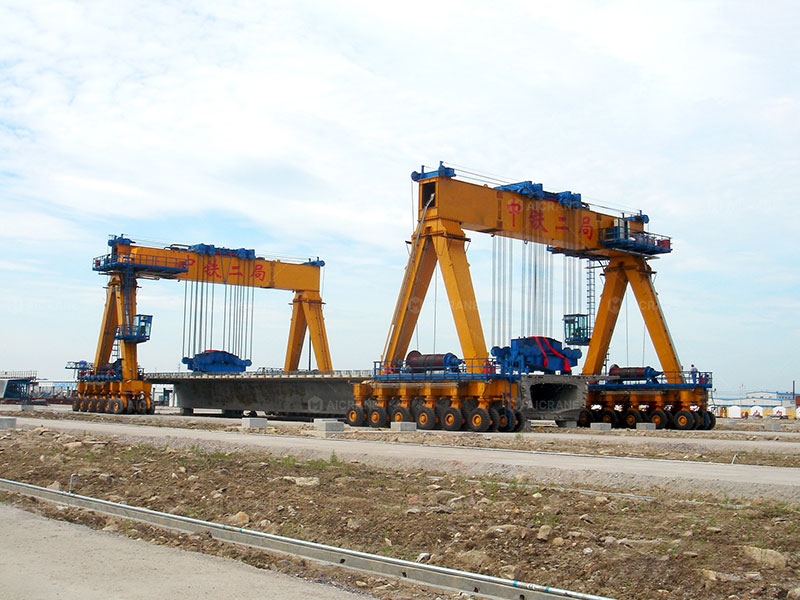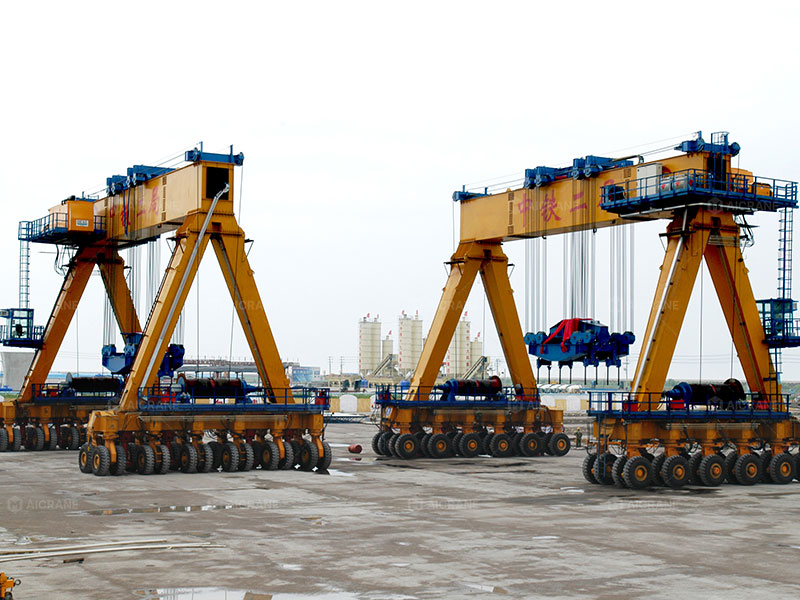Precast concrete yards are dynamic environments where efficiency, precision, and safety are critical. Among the essential equipment in these facilities are straddle carrier gantry cranes, purpose-built machines designed to handle, transport, and stack large precast concrete elements such as beams, slabs, and girders. These cranes must meet strict structural requirements to ensure reliability under heavy workloads, adaptability to varying yard layouts, and durability in challenging outdoor conditions. This article explores in detail the structural requirements of straddle carrier gantry cranes in precast concrete yards, focusing on design considerations, material choices, load-handling capability, and safety features.

1. Load-Bearing Capacity and Structural Integrity
The foremost requirement for a straddle carrier crane is its ability to withstand substantial loads. Precast concrete elements often weigh tens of tons, with irregular shapes and uneven load distribution. The crane’s frame must therefore be engineered with:
-
High-strength steel structures: Typically, structural steel grades with excellent tensile strength and fatigue resistance are used, allowing the crane to endure repeated heavy lifting cycles.
-
Finite element analysis (FEA) design: Modern cranes are designed using FEA to assess stress points, deflections, and dynamic responses, ensuring optimal load-bearing capability without excessive weight in the structure.
-
Redundant support systems: For safety, the legs, girders, and joints must be reinforced to resist buckling, torsion, and fatigue under maximum rated loads.
In practical terms, straddle carrier gantry cranes must be designed for static loads (from concrete components) and dynamic loads (from acceleration, braking, and wind effects) simultaneously.
2. Span and Clearance Requirements
Unlike traditional gantry cranes that often operate along fixed tracks, straddle carrier gantry cranes are mobile and must straddle the loads directly. Their structural dimensions – span, height, and clearance – are critical in precast yards:
-
Wide spans: The mobile gantry crane must be wide enough to straddle concrete beams or slabs laid out on the ground or on molds. Custom spans are often required based on the yard’s production layout.
-
High lifting clearance: To stack elements vertically or move them over molds, the crane must provide sufficient vertical clearance. The structural legs are therefore taller and designed with stability reinforcements to prevent sway.
-
Adjustable clearance designs: Some advanced models feature telescopic legs or modular structures that can adapt to different precast product sizes, enhancing yard flexibility.
The structural geometry must balance clearance requirements with stability to prevent tipping during operation.

3. Mobility and Structural Rigidity
Precast concrete yards are large and open, requiring cranes that can move efficiently across uneven or partially paved surfaces. The structural requirements here include:
-
Robust wheel assemblies: Large-diameter wheels or rubber-tyred systems distribute weight evenly to minimize ground pressure. The structure must integrate axle supports and load transfer mechanisms that prevent deformation of the crane frame.
-
Frame rigidity: The traveling motion generates lateral forces, especially during turning. A rigid structural frame with cross-bracing and torsional reinforcements is crucial to prevent misalignment or excessive deflection.
-
Articulated steering designs: For maneuverability, the rubber tire crane often requires multiple steering modes (e.g., transverse, diagonal, or carousel steering). The structural frame must be engineered to accommodate these dynamic stresses without compromising durability.
Thus, the combination of mobility and rigidity is a defining characteristic of straddle carrier gantry cranes.
4. Stability Against Environmental Forces
Operating outdoors in precast concrete yards exposes cranes to wind, rain, temperature fluctuations, and seismic activity. Structural design must ensure long-term stability and safety:
-
Wind resistance: Large gantry crane surfaces can act as sails. Engineers design lattice or box girder structures to minimize wind loads and prevent overturning.
-
Corrosion protection: Since outdoor yards are prone to humidity and exposure, crane structures are treated with hot-dip galvanization, epoxy coatings, or anti-corrosion paints to extend service life.
-
Temperature tolerance: Structural steel must be selected for resilience against expansion, contraction, or brittleness caused by extreme heat or cold.
-
Seismic considerations: In earthquake-prone areas, additional reinforcement and base anchoring systems may be required to prevent structural collapse.
These requirements ensure the crane operates safely in diverse environmental conditions.
5. Load Handling and Hoisting Structures
The load-handling system is at the core of straddle carrier gantry crane operations. Structurally, it must align with the nature of precast components:
-
Multiple lifting points: Precast elements often require lifting from multiple points to prevent cracking. The structural beam system must allow spreader beams, lifting frames, or slings to attach securely.
-
Hoist integration: Electric wire rope hoists or hydraulic lifting systems are integrated into the structural frame. The girder and trolley tracks must be designed to distribute hoist forces evenly without causing structural fatigue.
-
Anti-sway and stability systems: Structural reinforcements allow integration of anti-sway mechanisms, ensuring safe and precise load positioning.
The lifting structure must therefore balance strength, flexibility, and adaptability.
6. Modular and Customizable Designs
Precast concrete yards often have unique layouts, requiring cranes tailored to specific workflows. Structurally, this translates into:
-
Modular frames: The ability to expand or reduce span, leg height, or load capacity depending on evolving yard requirements.
-
Bolt-on reinforcements: Instead of complete redesigns, bolt-on extensions or reinforcements allow upgrades in load capacity or clearance.
-
Ease of assembly and disassembly: Modular structures allow for quicker crane installation, relocation, or maintenance, which is vital in growing precast operations.
This adaptability ensures the crane remains a long-term asset for the yard.
7. Safety-Related Structural Features
The structure of straddle carrier gantry cranes must integrate safety considerations directly:
-
Overload protection: Structural frames are designed with safety margins, typically 125–150% of rated load capacity.
-
Collision protection: Shock-absorbing bumpers and reinforced end stops prevent structural damage during accidental impacts.
-
Emergency stability: Outriggers or stabilizers may be structurally integrated to provide additional stability during critical lifts.
-
Inspection access: Platforms, ladders, and walkways are built into the structure for safe inspection and maintenance.
Safety is inseparable from structural design, particularly when handling heavy and fragile precast components.
8. Compliance with International Standards
Finally, structural requirements must align with recognized engineering and safety standards, such as:
-
FEM (Federation Europeenne de la Manutention)
-
ISO crane standards
-
OSHA safety regulations (for U.S. operations)
-
EN 1993 (Eurocode for steel structures)
Adherence to these standards ensures not only crane safety and performance but also legal compliance and customer confidence.
Conclusion
Straddle carrier gantry cranes play a vital role in precast concrete yards, where the handling of massive, heavy, and irregularly shaped elements demands robust and well-engineered equipment. The structural requirements – spanning load-bearing capacity, clearance, mobility, stability, load-handling integration, modularity, safety, and compliance – are all interconnected to deliver cranes that are safe, efficient, and durable. By investing in cranes that meet these structural benchmarks, precast yard operators can optimize workflow efficiency, minimize downtime, and ensure long-term operational safety.
In short, the structural design of straddle carrier gantry cranes is not merely about lifting power – it is about creating a reliable backbone for modern precast concrete production and logistics.